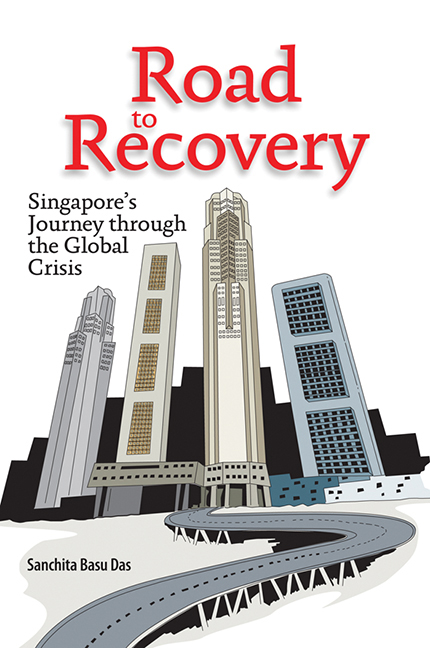Book contents
- Frontmatter
- Dedication
- Contents
- List of Tables
- List of Figures
- List of Boxes
- Foreword
- Acknowledgements
- Abbreviations
- 1 Introduction
- 2 Global Financial and Economic Crisis: Causes, Impact, and Policy Response
- 3 Impact of Global Economic Crisis on Singapore
- 4 Singapore's Policy Responses to the Global Economic Crisis
- 5 Singapore Economic Perspective and Future Policy Directions
- 6 Lessons Learnt
- Appendix I MAS Monetary Policy Statements
- Appendix II Key Budget FY2009 Initiatives
- Appendix III Summary of the ESC Key Recommendations
- Appendix IV Key Budget FY2010 Initiatives
- References
- Index
- About the Author
3 - Impact of Global Economic Crisis on Singapore
Published online by Cambridge University Press: 21 October 2015
- Frontmatter
- Dedication
- Contents
- List of Tables
- List of Figures
- List of Boxes
- Foreword
- Acknowledgements
- Abbreviations
- 1 Introduction
- 2 Global Financial and Economic Crisis: Causes, Impact, and Policy Response
- 3 Impact of Global Economic Crisis on Singapore
- 4 Singapore's Policy Responses to the Global Economic Crisis
- 5 Singapore Economic Perspective and Future Policy Directions
- 6 Lessons Learnt
- Appendix I MAS Monetary Policy Statements
- Appendix II Key Budget FY2009 Initiatives
- Appendix III Summary of the ESC Key Recommendations
- Appendix IV Key Budget FY2010 Initiatives
- References
- Index
- About the Author
Summary
After the onset of the global economic crisis in 2008, Singapore had become the first East Asian nation to fall into recession. The year-on-year growth rate had plunged from 7.7 per cent in 2007 to 4.5 per cent in H1-2008 (first half of 2008) and further to –9.5 per cent in Q1-2009 (first quarter of 2009). Although the exposure of Singapore's banks to sub-prime mortgage-linked securities was limited, the recession came mainly through the fall in non-oil exports. This is especially because Singapore has maintained an outward-looking policy over the past decade and has reduced barriers to international trade and investment. Its total trade to GDP ratio of close to 300 per cent is among the highest in the world, thus raising the economy's vulnerability to global economic shocks.
Transmission of Global Crisis to Singapore
There were at least three ways that the global developments were transmitted to the Singapore economy. While the financial sector was affected by the cessation of credit flows, the real economy suffered as the external demand for manufactured goods choked up. In addition, it was the working class that suffered from the worst consequences of the economic recession.
Impact on the Real Sector
Singapore's economy took a severe pounding from global financial sector turmoil and growth slowdown as the country's GDP shrank by an alarming rate of 15.2 per cent and 7.1 per cent quarter-on-quarter (q/q) seasonally adjusted annualized rate (saar) in Q4-2008 and Q1-2009 respectively. Year-on-year, the growth rate fell for three consecutive periods before hitting a low of –9.5 per cent in Q1-2009 (Figure 3.1).
This striking weakness in the Singapore real economy had been largely due to a marked contraction in the manufacturing sector (Figure 3.2). Production was badly depressed on the back of falling global export demand. The two key export destinations, the United States and Europe, grappling with the financial turmoil, still account for more than 33 per cent of the total non-oil exports (Table 3.1).
- Type
- Chapter
- Information
- Road to RecoverySingapore's Journey through the Global Crisis, pp. 44 - 69Publisher: ISEAS–Yusof Ishak InstitutePrint publication year: 2010

